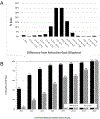Risk Factors Associated with Unexpected Refractive Outcomes in Uveitic Cataract Surgery
- PMID: 36931285
- PMCID: PMC10505240
- DOI: 10.1080/09273948.2023.2187847
Risk Factors Associated with Unexpected Refractive Outcomes in Uveitic Cataract Surgery
Abstract
Objective: Assess refractive outcomes following uveitic cataract surgery and identify factors associated with deviations from the target refractive goal.
Methods: A multicenter retrospective chart review was performed for 216 subjects with uveitis undergoing cataract surgery. Prediction error was calculated and tested for association with demographic and clinical characteristics using single variable and multiple regression analysis.
Results: 39.8% of eyes deviated from the intended refractive target by at least 0.5 diopters (D). The mean prediction error was 0.56 ± 0.67 D. Younger age (p = 0.042), preoperative inflammatory corneal findings (keratic precipitates and/or band keratopathy) (p = 0.0004), and poorer postoperative visual acuity (p = 0.0054) were associated with a deviation from the intended refractive target by at least 1 D.
Conclusions: A higher percentage of eyes undergoing uveitic cataract surgery deviated from the intended refractive target when compared to reported refractive outcomes in normal subjects. Younger age, preoperative inflammatory corneal sequelae, and poorer postoperative visual acuity were associated with this outcome.
Keywords: Cataract surgery; prediction error; refractive outcomes; uveitic; uveitis.
Conflict of interest statement
Figures
Similar articles
-
Non-steroidal anti-inflammatory drugs versus corticosteroids for controlling inflammation after uncomplicated cataract surgery.Cochrane Database Syst Rev. 2017 Jul 3;7(7):CD010516. doi: 10.1002/14651858.CD010516.pub2. Cochrane Database Syst Rev. 2017. PMID: 28670710 Free PMC article.
-
Prophylactic non-steroidal anti-inflammatory drugs for the prevention of macular oedema after cataract surgery.Cochrane Database Syst Rev. 2016 Nov 1;11(11):CD006683. doi: 10.1002/14651858.CD006683.pub3. Cochrane Database Syst Rev. 2016. PMID: 27801522 Free PMC article.
-
Laser-assisted subepithelial keratectomy (LASEK) versus laser-assisted in-situ keratomileusis (LASIK) for correcting myopia.Cochrane Database Syst Rev. 2017 Feb 15;2(2):CD011080. doi: 10.1002/14651858.CD011080.pub2. Cochrane Database Syst Rev. 2017. PMID: 28197998 Free PMC article.
-
Laser-assisted cataract surgery versus standard ultrasound phacoemulsification cataract surgery.Cochrane Database Syst Rev. 2016 Jul 8;7(7):CD010735. doi: 10.1002/14651858.CD010735.pub2. Cochrane Database Syst Rev. 2016. Update in: Cochrane Database Syst Rev. 2023 Jun 23;6:CD010735. doi: 10.1002/14651858.CD010735.pub3. PMID: 27387849 Free PMC article. Updated.
-
A prospective study to compare the safety and efficacy of toric intra-ocular lens vs. opposite clear corneal incision in patients undergoing phacoemulsification for age-related cataract with pre-existing corneal astigmatism.Rom J Ophthalmol. 2025 Jan-Mar;69(1):74-82. doi: 10.22336/rjo.2025.13. Rom J Ophthalmol. 2025. PMID: 40330970 Free PMC article. Clinical Trial.
References
-
- Chu CJ, Dick AD, Johnston RL, et al. Cataract surgery in uveitis: a multicentre database study. Br J Ophthalmol 2017;101(8):1132–7. - PubMed
-
- Kang YH, Lee JH. Phacoemulsification and posterior chamber intraocular lens implantation in uveitis. Korean J Ophthalmol 1997;11(2):94–7. - PubMed
-
- Zaborowski AG, Quinn AG, Gibbon CE, et al. Cataract surgery with primary intraocular lens implantation in children with chronic uveitis. Arch Ophthalmol 2008;126(4):583–4. - PubMed
-
- Quinones K, Cervantes-Castaneda RA, Hynes AY, et al. Outcomes of cataract surgery in children with chronic uveitis. J Cataract Refract Surg 2009;35(4):725–31. - PubMed
-
- Akova YA, Kucukerdonmez C, Gedik S. Clinical results of phacoemulsification in patients with uveitis. Ophthalmic Surg Lasers Imaging 2006;37(3):204–11. - PubMed
Publication types
MeSH terms
Grants and funding
LinkOut - more resources
Full Text Sources
Other Literature Sources

